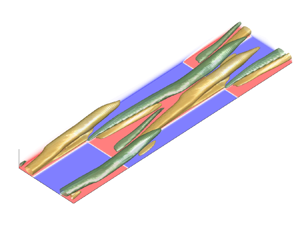Article contents
Secondary flows induced by two-dimensional surface temperature heterogeneity in stably stratified channel flow
Published online by Cambridge University Press: 30 August 2023
Abstract

The structure and impact of thermally induced secondary motions in stably stratified channel flows with two-dimensional surface temperature inhomogeneities is studied using direct numerical simulation (DNS). Starting from a configuration with only spanwise varying surface temperature, where the streamwise direction is homogeneous (Bon & Meyers, J. Fluid Mech., 2022, pp. 1–38), we study cases where the periodic temperature strip length  $l_x/h$ (with
$l_x/h$ (with  $h$ the half-channel height) assumes finite values. The patch width (
$h$ the half-channel height) assumes finite values. The patch width ( $l_y/h =\{{\rm \pi} /4, {\rm \pi}/8$}) and length are varied at fixed stability and two different Reynolds numbers. Results indicate that for the investigated patch widths, the streamwise development of the secondary flows depends on the patch aspect ratio (
$l_y/h =\{{\rm \pi} /4, {\rm \pi}/8$}) and length are varied at fixed stability and two different Reynolds numbers. Results indicate that for the investigated patch widths, the streamwise development of the secondary flows depends on the patch aspect ratio ( $a=l_x/l_y$), while they reach a fully developed state after approximately
$a=l_x/l_y$), while they reach a fully developed state after approximately  $25l_y$. The strength of the secondary motions, and their impact on momentum and heat transfer through the dispersive fluxes, is strongly reduced as the length of the temperature strips decreases, and becomes negligible when
$25l_y$. The strength of the secondary motions, and their impact on momentum and heat transfer through the dispersive fluxes, is strongly reduced as the length of the temperature strips decreases, and becomes negligible when  $a\lesssim 1$. We demonstrate that upward dispersive and turbulent heat transport in locally unstably stratified regions above the high-temperature patches lead to reduced overall downward heat transfer. Comparison to local Monin–Obukhov similarity theory (MOST) reveals that scaled velocity and temperature gradients in homogeneous stably stratified channel flow at
$a\lesssim 1$. We demonstrate that upward dispersive and turbulent heat transport in locally unstably stratified regions above the high-temperature patches lead to reduced overall downward heat transfer. Comparison to local Monin–Obukhov similarity theory (MOST) reveals that scaled velocity and temperature gradients in homogeneous stably stratified channel flow at  $Re_\tau =550$ agree reasonably well with empirical correlations obtained from meteorological data. For thermally heterogeneous cases with strips of finite length, the similarity functions only collapse higher above the surface, where dispersive fluxes are negligible. Lastly, we show that mean profiles of all simulations collapse when using outer-layer scaling based on displacement thickness.
$Re_\tau =550$ agree reasonably well with empirical correlations obtained from meteorological data. For thermally heterogeneous cases with strips of finite length, the similarity functions only collapse higher above the surface, where dispersive fluxes are negligible. Lastly, we show that mean profiles of all simulations collapse when using outer-layer scaling based on displacement thickness.
- Type
- JFM Papers
- Information
- Copyright
- © The Author(s), 2023. Published by Cambridge University Press
References
- 4
- Cited by



